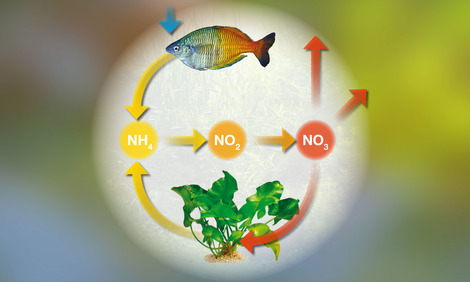Bacterial preparations for aquariums have been on the market for more than 20 years. That’s a very long time. From the start they were used to establish healthy bacterial flora or as an emergency measure to quickly add fish to a freshly set up aquarium.
And the discussions about the products are as old as the products themselves. We often hear questions like “Does it work?”, “Why do you need it?”, “How does it work?” and so on. What all these questions tell us is that more information is needed about this subject.
Why those products make sense
Did you know that the beneficial and important cleansing bacteria take a long time to develop? They are very sensitive and die off when there is not enough nutrition available. That’s the reason why many aquariums suddenly have high amounts of nitrite (NO2) or ammonia (NH4) in the water after the initial fish stock has been added. Even after a long run-in phase this can happen- or should we say despite the “conventional” run-in phase? The necessary bacteria haven’t had a chance to develop and the lack of food means they need longer to adapt to the changed conditions. To ensure that this problem event does not occur in the first place, we recommend the use of bacteria starters in all aquariums, such as JBL Denitrol along with moderate fish stocking. This way this potentially critical situation won’t develop into something worse – and your fish will benefit.
There are also situations which preclude a classical run-in phase. And this can happen to any aquarium owner, whether experienced or beginning: the aquarium bursts and the new aquarium needs to be installed immediately, the filter malfunctions or needs to be replaced, the application of a medication has killed the bacteria. There are many other situations which can preclude a run-in phase of 14-21 days without fish stock. Here is no way around it: you will need cleansing bacteria.
Why are these bacteria so important?
Living creatures in water generate waste. That’s why our aquariums need bacteria to transform the waste into harmless substances. These bacteria develop only very slowly, depending on the food supply. The addition of bacteria starters, such as JBL Denitrol , supports their colonisation and accelerates the process.
As the workload increases some bacteria reproduce rapidly. But they are not the bacteria needed for breaking down ammonia and nitrite. Those essential bacteria are delicate and slow to develop. Their development is delayed and they have to deal with a rapidly increased work load.
The phenomena of the bacterial bloom (milky water) isn’t caused by “good” bacteria (Nitrosomas and Nitrobacter), but by the so-called heterotrophic bacteria, which are able to reproduce very rapidly.
The run-in phase - no longer needed?
How do you define this phase? Each aquarium needs a certain time until it is “robust” enough to deal with small problems. But to ensure that the bacteria cultures develop steadily the aquarium start should be initiated with a bacteria starter. This doesn’t mean that the complete fish stock can be added. This would not only be wrong, it would also be boring. We recommend all aquarium owners to observe the run-in phase of their aquarium closely; the first 14 to 21 days are fascinating as you see life forms developing slowly and in great detail. Roots emerge, bacterial lawn forms on structural features and here and there small snails appear. Life evolves. It is no great loss to have a fishless aquarium at this stage and it is vital for the development of the cleansing bacteria.
What do cleansing bacteria require?
In order to work cleansing bacteria need oxygen, CO2 for nutrition and most importantly, somewhere to settle. Reproduction can only take place within this settlement area and if all the “houses” are occupied, no further development is possible. Reproduction is therefore limited.
In aquariums the bacteria choose the filter media, the substrate and the decorative elements (wood and stones etc.) as their settlement area. A few bacteria may be floating in the water, but their effect is negligible. Cleansing bacteria live “substrate-bound”.
Dosing bacteria starters
Current research shows that a high, one-off dosage causes the cleansing bacteria to work better and more immediately. For many years we have been recommending several dosages over a period of several days. This way showed good results, but following the latest research about dosing has led us to even better ones. A mixture of heterotrophic and autotrophic strains of cleansing bacteria detoxify the water by breaking down proteins, ammonium, ammonia and nitrite. The cleansing bacteria’s specific enzymes degrade the fish’s excrements and other waste and maintain the biological balance in the aquarium.
The most important fact – the fish stock – is often neglected due to scepticism and lack of knowledge. If the fish are not added immediately the newly inserted cleansing bacteria will soon die from lack of nutrition. Even if you add the fish a few days later (not following the instructions), it can already be too late and problems with ammonium/ammonia and nitrite occur as in/after a classic run-in phase. We therefore recommend you stock the aquarium moderately with a few fish immediately after adding the bacteria starter. This ensures that enough cleaning bacteria are available from the start and neither ammonium/ammonia nor nitrite will cause problems.
The fish stock can be increased one by one after 14 days.
If you want to be on the safe side you can also add JBL Denitrol in the following days. Dosing up to factor 5 is harmless.
In the second part of the series “Bacteria starter – starting without a 14 day run-in phase” we will discuss the properties of the bacteria and further background information.
